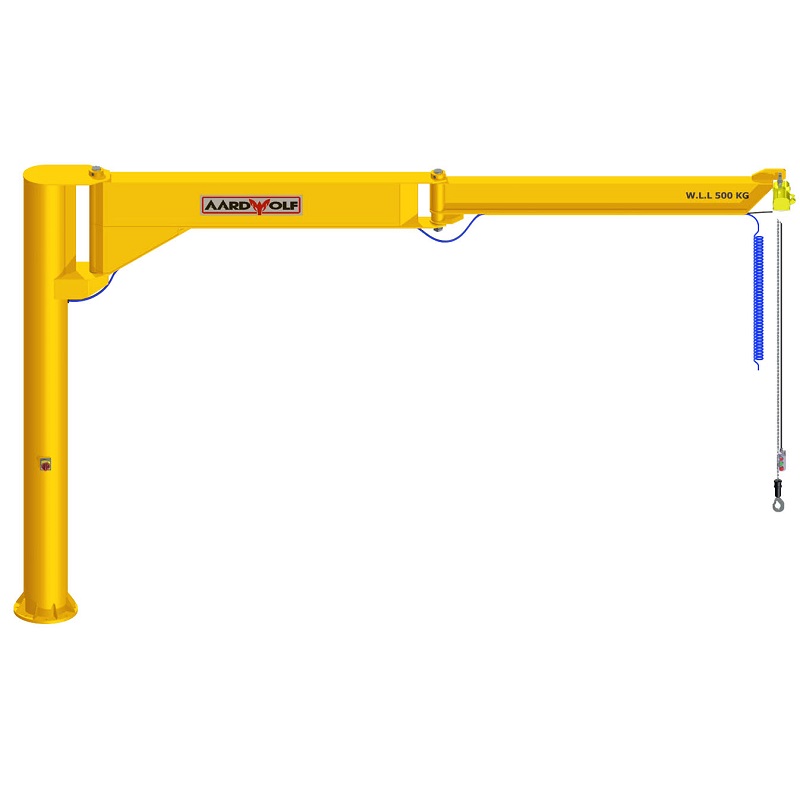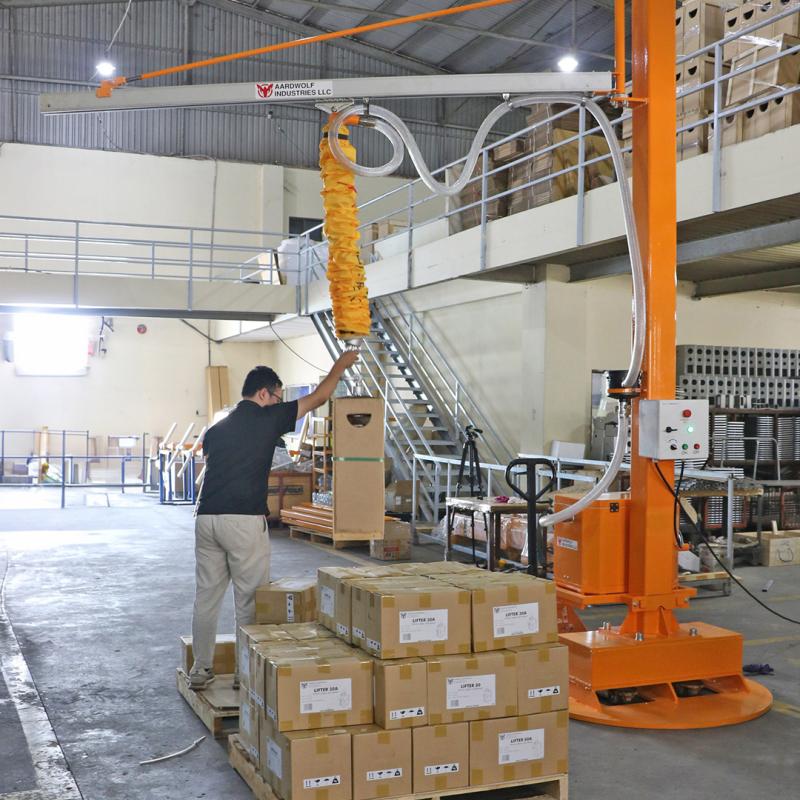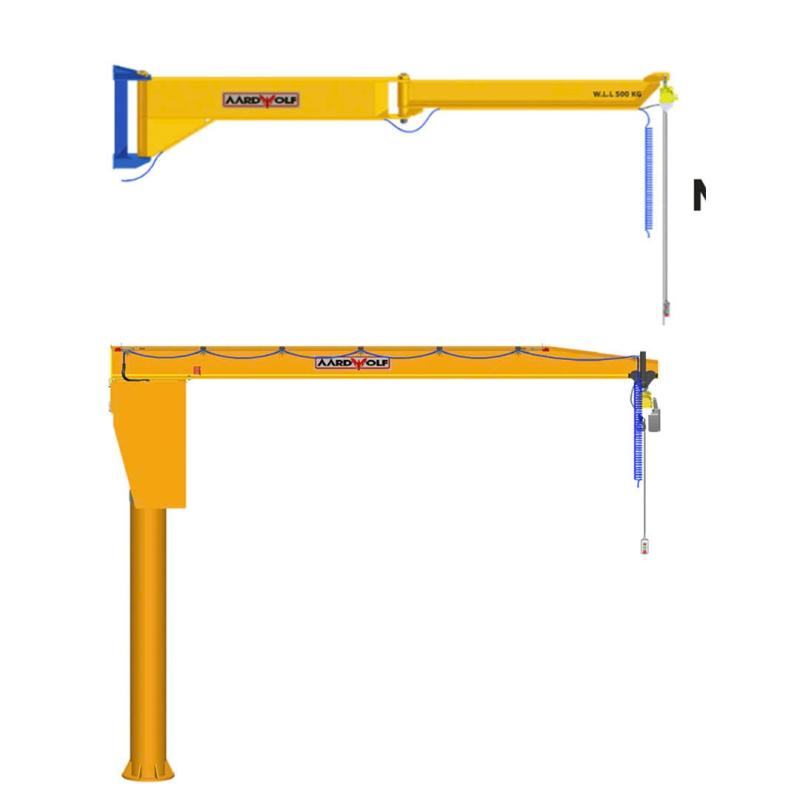



While the boom serves as the main lifting arm, the jib functions as an extension to increase reach and maneuverability. Together, they define how a crane operates in complex job site environments.
Whether you're involved in construction, manufacturing, or marine logistics, understanding what a jib boom crane is—and how it functions—can dramatically improve safety, efficiency, and equipment choice.
A boom is the primary lifting structure of a crane. It handles the bulk of the lifting capacity and determines the crane’s vertical reach. Booms come in different types, including:
Telescopic booms – Extend and retract using hydraulics.
Lattice booms – Provide lightweight, high-strength lifting through trussed metal structures.
Connects directly to the crane’s base or turntable.
Supports heavy vertical lifts.
Can be adjusted in length (especially telescopic booms).
A jib crane is a type of overhead lifting device, typically used in smaller work areas for repetitive and specific lifting tasks. It features a horizontal arm, called a jib or boom, that extends from a vertical support (mast or wall). This jib allows the crane to move loads in an arc, providing access to a specific work area.
Fixed-angle (non-adjustable)
Luffing (adjustable angle)
Articulating (multi-jointed for precision)
Increases lateral coverage.
Handles lighter loads than the main boom.
Enhances reach for more intricate placements.


A jib boom crane is a crane equipped with both a main boom and a jib extension. This hybrid configuration provides the vertical strength of the boom and the horizontal flexibility of the jib. It’s ideal for projects requiring high lifts and long reach—such as high-rise construction, wind farm maintenance, and shipyard loading.
Mobile cranes with jibs
Mobile cranes with jibs are versatile lifting devices featuring a horizontal beam (the jib) extending from the crane, enabling lifting and moving of loads with precision and reach. These cranes are designed for mobility and can be used in various locations, including construction sites, workshops, and industrial facilities.
Key Features and Benefits:
Mobility: Mobile jib cranes can be moved and repositioned easily, unlike fixed jib cranes, making them adaptable to different work areas and tasks.
Jib Arm: The jib (or jib arm) is a horizontal beam that supports the hoist and allows for lifting and moving loads horizontally.
Versatility: Jib cranes with jibs can be used for a wide range of applications, including lifting materials, machinery, and other heavy objects.
Ergonomics: Some mobile jib cranes are designed with ergonomic considerations.
Applications - Jib cranes with jibs are used in various settings, such as:
Construction: Lifting building materials, placing equipment.
Industrial: Handling machinery, materials, and components in manufacturing plants.
Warehousing: Loading and unloading trucks, moving goods.
Maritime: Loading and unloading boats and ships.
Workshops: Lifting tools and materials.
Types of Mobile Jib Cranes
Freestanding jib cranes:
Can be installed in open areas or small workstations and offer higher lift capacities.
Mast-style jib cranes:
Mount to building columns or reinforced concrete floors and provide 360-degree rotation.
Portable base jib cranes:
Offer the lifting capacity of a jib crane with the added benefit of mobility.
Articulating jib cranes:
Feature a jib that can articulate (bend or pivot) to navigate around obstacles.
Foundationless jib cranes:
Can be installed on a slab without needing a special foundation.
Important Considerations:
Safety:
Proper training and adherence to safety procedures are essential when operating any type of crane.
Maintenance:
Regular maintenance is necessary to ensure smooth operation and prevent wear and tear.
Load Capacity:
The load capacity of a jib crane should be carefully considered to ensure it can handle the weight of the intended loads.
Tower cranes with luffing jibs
Luffing jib tower cranes are a type of tower crane that features a jib (the long, horizontal arm) that can be raised and lowered, or "luffed", to adjust its angle relative to the vertical mast. This contrasts with traditional tower cranes, which have fixed jibs. This luffing capability allows them to operate in confined spaces and congested urban areas where traditional cranes might not fit or be able to operate safely.
Key Features and Benefits:
Adjustable Jib Angle: Luffing jib cranes can change the angle of their jibs, allowing them to work in areas with limited space or where oversailing is a problem.
Compact Design: The ability to luff the jib reduces the crane's operating radius, making them suitable for projects in dense urban areas or where multiple cranes need to operate in close proximity.
Oversailing Avoidance: Luffing jibs can be raised to avoid overflying neighboring buildings, roads, or other obstacles, potentially saving time and money by avoiding the need for permits or agreements to oversail.
High-Rise Construction: Luffing jib cranes are particularly useful for high-rise construction projects where space is limited and multiple cranes may be needed.
Wind Resistance: Luffing jib cranes can be lowered in high winds, which can improve their stability and safety in adverse weather conditions.
How it Works:
Luffing jib cranes typically use a rope and pulley system or hydraulic cylinders to raise and lower the jib. Some cranes also incorporate a "park radius device" which allows the jib to be parked at a reduced radius when not in use, further maximizing space utilization.
Applications:
Luffing jib cranes are commonly used in:
Urban construction: Where space is limited and multiple cranes need to operate in close proximity.
High-rise building construction: Where the crane needs to work at a high radius and avoid obstacles.
Sites with oversailing restrictions: Where the crane needs to avoid overflying neighboring properties.
Sites with multiple cranes: Where the luffing capability allows for efficient crane operation in a congested area
Truck-mounted knuckle boom cranes with articulating jibs
Truck-mounted knuckle boom cranes, also known as articulating cranes, are versatile lifting machines featuring a hydraulically-powered arm with multiple sections that can fold and bend like a human finger. This design allows for increased reach and maneuverability, making them ideal for a wide range of jobs, particularly in construction, utilities, landscaping, and other industries where reaching tight or obstructed areas is necessary.
Versatility and Maneuverability:
Tight Spaces: Knuckle booms excel in situations where traditional boom cranes can't operate due to their ability to fold and maneuver in confined areas.
Obstacle Avoidance: The articulating boom allows for lifting over obstacles like walls, fences, or other structures, making them suitable for various construction and landscaping projects.
Precise Placement: The knuckle boom's flexibility and control enable accurate placement of materials, crucial for tasks like steel erection, roofing, and landscaping.
While the boom serves as the main lifting arm, the jib functions as an extension to increase reach and maneuverability. Together, they define how a crane operates in complex job site environments. Whether you're involved in construction, manufacturing, or marine logistics, understanding what a jib boom crane is—and how it functions—can dramatically improve safety, efficiency, and equipment choice.
A boom is the primary lifting structure of a crane. It handles the bulk of the lifting capacity and determines the crane’s vertical reach. Booms come in different types, including:
Telescopic booms – Extend and retract using hydraulics.
Lattice booms – Provide lightweight, high-strength lifting through trussed metal structures.
Connects directly to the crane’s base or turntable.
Supports heavy vertical lifts.
Can be adjusted in length (especially telescopic booms).
A jib crane is a type of overhead lifting device, typically used in smaller work areas for repetitive and specific lifting tasks. It features a horizontal arm, called a jib or boom, that extends from a vertical support (mast or wall). This jib allows the crane to move loads in an arc, providing access to a specific work area.
Fixed-angle (non-adjustable)
Luffing (adjustable angle)
Articulating (multi-jointed for precision)
Key Functions of a Jib:
Increases lateral coverage.
Handles lighter loads than the main boom.
Enhances reach for more intricate placements.
A jib boom crane is a crane equipped with both a main boom and a jib extension. This hybrid configuration provides the vertical strength of the boom and the horizontal flexibility of the jib. It’s ideal for projects requiring high lifts and long reach—such as high-rise construction, wind farm maintenance, and shipyard loading.
Key Features and Benefits:
Mobility: Mobile jib cranes can be moved and repositioned easily, unlike fixed jib cranes, making them adaptable to different work areas and tasks.
Jib Arm: The jib (or jib arm) is a horizontal beam that supports the hoist and allows for lifting and moving loads horizontally.
Versatility: Jib cranes with jibs can be used for a wide range of applications, including lifting materials, machinery, and other heavy objects.
Ergonomics: Some mobile jib cranes are designed with ergonomic considerations.
Applications - Jib cranes with jibs are used in various settings, such as:
Construction: Lifting building materials, placing equipment.
Industrial: Handling machinery, materials, and components in manufacturing plants.
Warehousing: Loading and unloading trucks, moving goods.
Maritime: Loading and unloading boats and ships.
Workshops: Lifting tools and materials.
Types of Mobile Jib Cranes
Freestanding jib cranes:
Can be installed in open areas or small workstations and offer higher lift capacities.
Mast-style jib cranes:
Mount to building columns or reinforced concrete floors and provide 360-degree rotation.
Portable base jib cranes:
Offer the lifting capacity of a jib crane with the added benefit of mobility.
Articulating jib cranes:
Feature a jib that can articulate (bend or pivot) to navigate around obstacles.
Foundationless jib cranes:
Can be installed on a slab without needing a special foundation.
Important Considerations:
Safety: Proper training and adherence to safety procedures are essential when operating any type of crane.
Maintenance: Regular maintenance is necessary to ensure smooth operation and prevent wear and tear.
Load Capacity: The load capacity of a jib crane should be carefully considered to ensure it can handle the weight of the intended loads.
2. Tower cranes with luffing jibs:
Key Features and Benefits:
Adjustable Jib Angle: Luffing jib cranes can change the angle of their jibs, allowing them to work in areas with limited space or where oversailing is a problem.
Compact Design: The ability to luff the jib reduces the crane's operating radius, making them suitable for projects in dense urban areas or where multiple cranes need to operate in close proximity.
Oversailing Avoidance: Luffing jibs can be raised to avoid overflying neighboring buildings, roads, or other obstacles, potentially saving time and money by avoiding the need for permits or agreements to oversail.
High-Rise Construction: Luffing jib cranes are particularly useful for high-rise construction projects where space is limited and multiple cranes may be needed.
Wind Resistance: Luffing jib cranes can be lowered in high winds, which can improve their stability and safety in adverse weather conditions.
How it Works:
Luffing jib cranes typically use a rope and pulley system or hydraulic cylinders to raise and lower the jib. Some cranes also incorporate a "park radius device" which allows the jib to be parked at a reduced radius when not in use, further maximizing space utilization.
Applications- Luffing jib cranes are commonly used in:
Urban construction: Where space is limited and multiple cranes need to operate in close proximity.
High-rise building construction: Where the crane needs to work at a high radius and avoid obstacles.
Sites with oversailing restrictions: Where the crane needs to avoid overflying neighboring properties.
Sites with multiple cranes: Where the luffing capability allows for efficient crane operation in a congested are
3.Truck-mounted knuckle boom cranes with articulating jibs
Truck-mounted knuckle boom cranes, also known as articulating cranes, are versatile lifting machines featuring a hydraulically-powered arm with multiple sections that can fold and bend like a human finger. This design allows for increased reach and maneuverability, making them ideal for a wide range of jobs, particularly in construction, utilities, landscaping, and other industries where reaching tight or obstructed areas is necessary.
Versatility and Maneuverability:
Tight Spaces: Knuckle booms excel in situations where traditional boom cranes can't operate due to their ability to fold and maneuver in confined areas.
Obstacle Avoidance: The articulating boom allows for lifting over obstacles like walls, fences, or other structures, making them suitable for various construction and landscaping projects.
Precise Placement: The knuckle boom's flexibility and control enable accurate placement of materials, crucial for tasks like steel erection, roofing, and landscaping.
Common Applications:
Construction: Lifting and placing building materials (steel, concrete, roofing materials), machinery, and equipment.
Utilities: Lifting poles, transformers, and other equipment for power line maintenance and construction.
Landscaping: Positioning trees, shrubs, and other landscaping elements, often in hard-to-reach areas.
Logistics and Transportation: Loading and unloading materials onto trucks, often with specialized attachments for specific cargo like logs or steel road plates.
Other Industries: Used in diverse sectors like marine, oil and gas, and infrastructure for various lifting and material handling tasks.
Key Features and Benefits:
Compact Design: The folding boom design allows for a smaller footprint when the crane is not in use, making it easier to transport and store.
Increased Payload: Knuckle boom cranes are designed to be lightweight yet powerful, maximizing payload capacity while maintaining maneuverability.
Multiple Attachments: These cranes can be equipped with a variety of attachments, including winches, jibs, and other tools, to handle a wide array of lifting and material handling needs.
Applications in Aardwolf Vietnam
Aardwolf Vietnam primarily focuses on the design, manufacturing, and distribution of material handling equipment, particularly for the stone and glass industries. Their products include slab lifters, A-frames, storage racks, and carts for stone, and glass lifters, frames, storage racks, and tables for glass. Aardwolf's equipment is used in real-world applications like:
1. Stone and Glass Industries
Slab Handling: Aardwolf's slab lifters are designed to securely handle heavy stone and glass slabs, minimizing the risk of damage and ensuring safety during lifting and transportation.
Storage and Transportation: A-frames, storage racks, and carts are used for organizing and moving stone and glass products in workshops and factories.
Glass Handling: Aardwolf's glass lifters are crucial for safely handling large, fragile glass panels.
2. Other Industries
Manufacturing: Jib cranes and other lifting equipment are used in various manufacturing processes, such as assembly lines and machine shops, for lifting and positioning heavy components.
Construction: Aardwolf's equipment, including slab lifters and scissor lifters, can be used on construction sites for lifting and positioning building materials.
Warehousing and Logistics: Overhead cranes and other lifting equipment help optimize warehouse operations for efficient storage and retrieval of goods.
Automotive Industry: Jib cranes and vacuum lifters are used for handling engine components and large panels in automotive manufacturing and repair.
3. Smart Crane Technologies
Aardwolf integrates smart features into their jib cranes, including predictive maintenance capabilities and real-time load monitoring. These smart cranes can improve efficiency, reduce downtime, and enhance safety in various industrial settings.
Understanding jib boom cranes is crucial for safety, efficiency, and compliance in various industries. Jib cranes, with their distinct horizontal arm (the jib), are essential for lifting and moving materials, especially in confined spaces and for repetitive tasks. Knowing how to select, operate, and maintain these cranes ensures safe and productive work environments.
Load Capacity:
Jib cranes have specific load limits for both the boom and the jib. Exceeding these limits can lead to dangerous situations, including tipping or structural failure.
Proper Setup and Operation:
Incorrect setup, such as overextending the boom or misusing the jib, is a major cause of lifting incidents.
Compliance:
Regulatory bodies have strict requirements for crane use. Understanding these requirements is essential to avoid legal issues and fines.
Trained Operators:
Regular equipment inspections and trained operators are crucial for safe crane operation.
Choosing the Right Crane: Different jib crane types (e.g., wall-mounted, floor-mounted, articulating, freestanding) are suited for specific tasks and environments.
Optimizing Space: Jib cranes are excellent for navigating tight spaces and supporting individual workstations.
Efficient Lifting: Jib cranes are designed for repetitive lifting tasks, making them ideal for manufacturing and other industries.
Customization: Understanding specifications allows for customization to fit workspace needs.
Material Handling: Jib cranes are vital for efficient material handling in various industries, including construction, manufacturing, and shipbuilding.
Increased Throughput: By optimizing lifting and moving processes, jib cranes contribute to increased productivity and faster workflows.
Reduced Downtime: Proper maintenance and understanding of the crane's capabilities can prevent costly repairs and downtime.
Longer Lifespan: Proper use and maintenance extend the crane's lifespan, reducing the need for frequent replacements.
Reduced Accidents: Safe operation minimizes the risk of accidents, saving on potential repair costs, legal fees, and lost productivity.

A jib boom crane combines the strength of a boom with the reach of a jib, making it a versatile solution for complex lifting tasks. Whether you're lifting over rooftops, maneuvering in tight industrial zones, or spanning large distances, understanding how jib boom cranes work ensures safer, smarter, and more effective operations.
Looking for the right crane configuration for your project? Consult certified lifting professionals to choose the safest and most cost-effective setup tailored to your needs.
1. How to operate a Jib Crane safely
3. Over brace jib crane wall mounted
5. Is a Jib Crane a Gantry Crane
6. Articulated Jib Crane Wall Mounted
8. Manual Counterbalance Crane
10. Over Braced Jib Crane Column Mounted
Sign up to receive the latest info on new Aardwolf products, special offers and more.
By signing up you agree to receive emails from Aardwolf with news, special offers, promotions and other information. You can unsubscribe at any time.